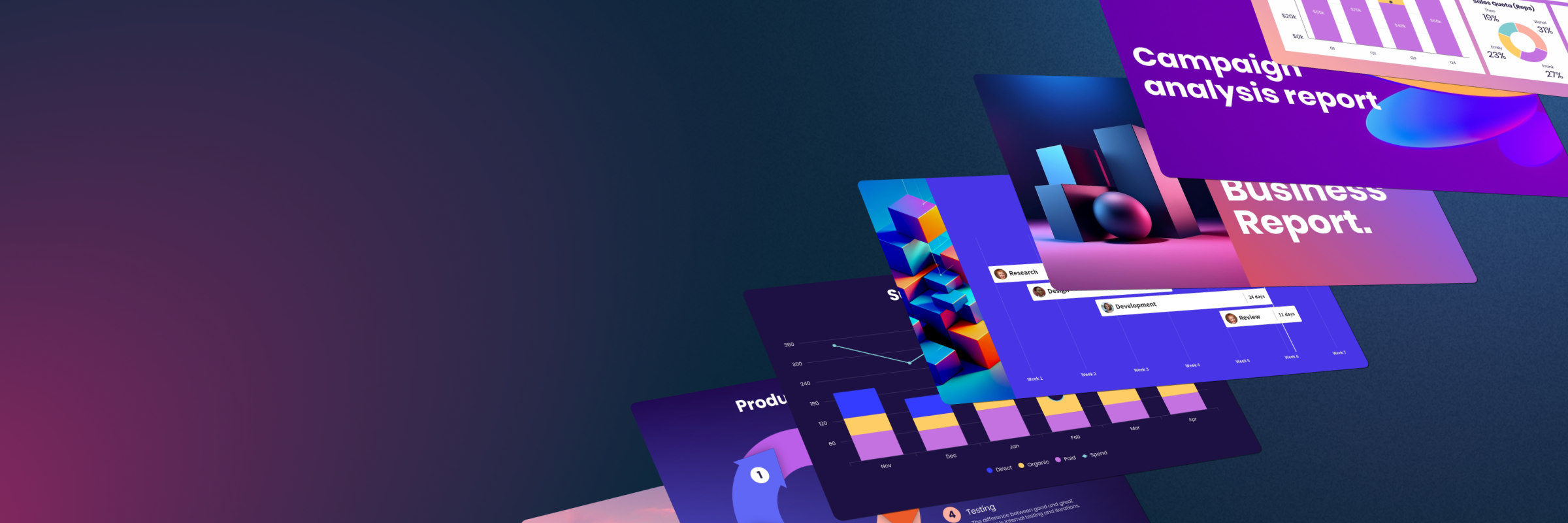
Every sales team knows the feeling: the year starts strong, Q2 dips, summer slows to a crawl, and then Q4 comes barreling in like a freight train. These peaks and valleys, commonly known as sales seasonality, are as predictable as they are frustrating. One minute you’re celebrating wins, the next you’re hustling just to hit minimum targets.
But here’s the good news: while seasonality is inevitable, inconsistency doesn’t have to be. The secret weapon? Smarter, data-informed, visually compelling sales presentations that help you get ahead of the seasons. When done right, your sales deck can be the most agile member of your team.
Let’s unpack how.
Understanding sales seasonality
First, you need to understand what you’re up against.
What is sales seasonality?
Sales seasonality refers to the natural fluctuations in buyer behavior that occur throughout the year. Think Q4 surges, end-of-year budget flushes, or the dreaded summer slump when decision-makers are out of office and inboxes go cold.
But not all cycles are created equal. Retail might thrive during the holidays, while B2B companies often see spikes during fiscal year planning in Q1 or Q3. Industry-specific fluctuations mean that understanding your market’s rhythm is crucial for timing pitches, allocating resources, and setting realistic goals.
Why it matters
These seasonal trends don’t just impact revenue, they trickle down to various other parts of the business.
Missing the rhythm in your forecasts can lead to costly missteps—either overestimating demand or failing to prepare sufficiently. This misalignment can throw resource planning off course, causing hiring and onboarding efforts to clash with peak periods instead of complementing them. The ripple effect extends to your sales team’s morale, too. No one wants to be overworked for diminishing returns or feel the pressure of last-minute scrambles to hit end-of-year targets.
Understanding sales seasonality, and planning accordingly, can be the difference between a successful sales team and one that misses the mark entirely.
Why traditional tactics don’t cut it
When confronted with a slow season, most teams go back to the basics: dial more, discount harder, push faster.
- Ramping up activity: More outreach, more follow-ups, more cold calls.
- Offering discounts: Slashing prices to close deals that might not even be a good fit.
- Overloading sales teams: Expecting reps to compensate for the slump through sheer hustle.
These tactics are reactive, short-term, and misallocate resources and talent. They don’t scale, they’re hard to sustain, and they often fail to meet the expectations of increasingly savvy buyers.
Presentations that sell smarter
So how do you proactively address seasonality? By elevating your communication style. Presentations are often an early touchpoint with the buyer, and can help flip the script. But to do so, you need to treat presentations as a dynamic, data-driven tool that adapts with the seasons rather than just another generic pitch deck.
1. Data-driven personalization
Seasonal messaging isn’t about guessing, it’s about knowing. Use customer insights and CRM data to tailor your story to the prospect.
- Highlight use cases that align with seasonal challenges.
- Show historical ROI during the same quarter from last year.
- Speak directly to the buyer’s seasonal priorities (e.g., “How to make the most of your remaining Q3 budget”).
When your pitch reflects real customer data, it resonates harder and closes faster.


2. Dynamic visual storytelling
To really connect with the prospect, use storytelling techniques that frame your solution as timely and relevant. For slower months, you might emphasize long-term gains and prep work for busier seasons. Similarly, during high-stakes quarters, zero in on ROI, urgency, and scalability.
With Beautiful.ai, it’s easy to flip data into a compelling story through charts, timelines, and infographics that are built to engage. Tailoring the story with personalized data and visualizations can help drive your pitch home.
3. Adaptive templates that keep you agile
No one has time to reinvent the wheel each quarter. Our Smart Slide templates help you adjust content and tone based on the season, or client, without starting from scratch. Need a Q4 end-of-year budget pitch? Done. Want to refresh your Q2 check-in deck for a summer-strategy twist? Simple.
Smart Slides make it easy to reuse content for quick personalization and scalability. No two prospects are the same, so no two pitches should be either. Adaptive templates allow you to customize your pitch for each client with little-to-no design lift.
Actionable tips to maximize seasonal impact
If you want to turn seasonality into a strategic advantage, here are a few ways to optimize your content.
Audit past & current decks
Look back at what worked—and what didn’t—during previous seasonal cycles. Beautiful.ai’s analytics tool gives you quick insights into who viewed your deck, and when, and which slides they spent the most time on. Tracking engagement shows you who’s watching, what’s resonating, and where to improve.
Align with buyer timelines
Do your due diligence. Half the battle of your pitch is knowing who you’re pitching to and meeting them where they’re at. If your prospects plan budgets in Q3, make sure your pitch lands early enough to influence it.
A/B test formats
When you’re competing with seasonality, use the slower season as an opportunity to A/B test and iterate on your strategy. Experiment with different deck structures and see what drives more engagement in different markets and seasons. Beautiful.ai’s Smart Slides make it easy to toggle between different layouts and templates without losing your content, so you can test new formats without starting from a blank slide.
.jpeg)

Collaborate in real time
Sales and marketing alignment is critical during crunch time. When the sales pipeline is skinny, tap marketers to piggyback off of any campaigns that may help drive marketing qualified leads. You can also collaborate with client-facing colleagues on your pitch with real-time comments and version control to stay in sync and tailor your deck to meet market needs.
Seasonality isn’t going away. Instead of stressing the dips and scrambling during the peaks, you can work smarter with tools like Beautiful.ai. Presentations can (and should) be strategic, adaptable assets that help you win deals all year long.




_listing.webp)


